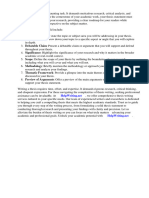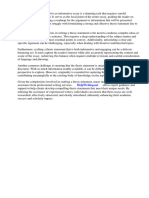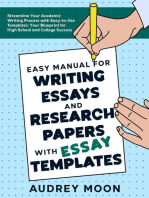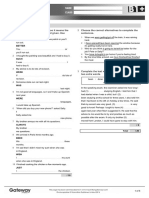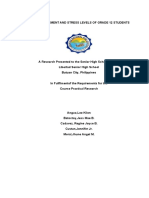How to write cause and effect essay
How to write cause and effect essay
Uploaded by
alisinaalipoorCopyright:
Available Formats
How to write cause and effect essay
How to write cause and effect essay
Uploaded by
alisinaalipoorCopyright
Available Formats
Share this document
Did you find this document useful?
Is this content inappropriate?
Copyright:
Available Formats
How to write cause and effect essay
How to write cause and effect essay
Uploaded by
alisinaalipoorCopyright:
Available Formats
HOW TO WRITE CAUSE
AND EFFECT ESSAY
Prepared by: Ahmad Fardin Zahedi
WHAT IS THE CAUSE AND
EFFECT?
• Writing a cause and effect essay
involves exploring the reasons for a
particular event or phenomenon (the
cause) and the outcomes or
consequences of that event (the effect).
Here is a step-by-step guide on how to
write a cause and effect essay:
1. . Choose a topic: Select a topic that interests you
and has clear cause and effect relationships.
Make sure the topic is specific enough to be
manageable within the scope of your essay.
2. . Choose a topic: Select a topic that interests you
and has clear cause and effect relationships.
Make sure the topic is specific enough to be
manageable within the scope of your essay.
3. . Choose a topic: Select a topic that interests you
and has clear cause and effect relationships.
Make sure the topic is specific enough to be
manageable within the scope of your essay.
INTRODUCTION
1. Start with a hook to grab the reader's
attention.
2.- Provide some background information on
the topic.
3.- State your thesis statement, which should
clearly outline the cause-effect relationship
you will be discussing.
BODY PARAGRAPHS
1. Each body paragraph should focus on a
specific cause or effect.
2.- Provide evidence and examples to support
each point.
3.- Use transitional phrases to connect ideas
and maintain coherence.
CONCLUSION
Summarize the main points discussed in
1. -
the essay.
2. - Restate the thesis statement in different
words.
3. - Reflect on the significance of the cause-
effect relationship and its implications.
REVISE AND EDIT
Review your essay for clarity, coherence,
1. -
and accuracy.
2.- Check for grammar, punctuation, and
spelling errors.
3.- Make sure your essay flows smoothly from
one point to the next.
FINALIZE YOUR ESSAY
• -Make any necessary revisions based on feedback or self-
assessment.
• - Ensure that your essay meets all requirements and
guidelines.
By following these steps, you can effectively write a
cause and effect essay that explores the relationships
between different events or phenomena. Remember to
provide strong evidence and examples to support your
arguments and maintain a clear structure throughout
your essay.
TO CREATE A COMPELLING HOOK FOR YOUR
CAUSE AND EFFECT ESSAY INTRODUCTION,
CONSIDER USING ONE OF THE FOLLOWING
STRATEGIES
• 1. Start with a surprising fact or statistic: Begin your introduction
with a startling statistic or fact related to your topic to capture the
reader's attention. For example, "Did you know that over 80% of
car accidents are caused by distracted driving?"
• 2. Pose a thought-provoking question: Engage your readers by
posing a question that encourages them to think about the topic
you will be discussing. For instance, "What are the long-term
effects of social media addiction on mental health?"
• 3. Tell a relevant anecdote or story: Share a brief personal
story or anecdote that illustrates the impact of the cause-
effect relationship you will be exploring. This can help create
an emotional connection with the reader.
• 4. Use a powerful quote: Incorporate a relevant quote from
a notable figure or source that sets the tone for your essay
and highlights the significance of the cause-effect
relationship. Make sure the quote is impactful and relevant
to your topic.
• 5. Paint a vivid picture: Use descriptive language to paint a
vivid picture of the consequences of the cause-effect
relationship you will be discussing. This can help draw the
reader into your essay and make them curious to learn
more.
WHAT IS CONNECTESD INFORMATION?
• In an essay introduction, the connected information typically
includes background information, context, and a thesis statement.
Here's how these elements are connected in an essay introduction:
1. In an essay introduction, the connected information
typically includes background information, context, and
a thesis statement. Here's how these elements are
connected in an essay introduction:
2. Context: The context in an essay introduction helps
frame the discussion by explaining why the topic is
important or relevant. It may discuss current events,
societal issues, or academic debates related to the topic.
Providing context helps the reader understand the
significance of the topic and why it is worth exploring
further.
• 3: Thesis statement: The thesis statement is the central
argument or main point of the essay. It typically appears
at the end of the introduction and outlines the main idea
that the rest of the essay will support. The thesis
statement should be clear, concise, and specific, guiding
the reader on what to expect in the body of the essay.
• By connecting background information, context, and a
thesis statement in the introduction, you are setting up a
strong foundation for your essay. The background
information provides necessary details, the context
explains the relevance of the topic, and the thesis
statement presents the central argument that will be
developed throughout the essay. This connected
information helps guide the reader through your essay
and prepares them for the discussion that follows.
HOW TO WRITE A THESIS
STATEMENT?
1. Identify the main cause and effect: Start by identifying the main cause and effect you will
be focusing on in your essay. Determine the relationship between the two elements and
how they are connected.
2. 2. Make it specific: Your thesis statement should clearly state the specific cause and
effect you will be exploring in your essay. Avoid vague or general statements and instead
focus on a specific relationship between the cause and effect.
3. 3. Use clear language: Your thesis statement should be clear, concise, and easy to
understand. Avoid using complex language or jargon that may confuse the reader. State
your main point in a straightforward manner.
4. 4. Provide a roadmap: Your thesis statement should also provide a roadmap for your
essay. Briefly mention how you will support your thesis in the body of your essay. This
helps guide the reader on what to expect in the rest of the paper.
5. 5. Revise and refine: After writing your thesis statement, revise it to ensure it is clear,
specific, and effectively conveys the main idea of your essay. Make any necessary
You might also like
- What Women Want When They Test Men (PDFDrive)Document100 pagesWhat Women Want When They Test Men (PDFDrive)Ankit Jaat100% (1)
- Lesson 5 Outlining Reading Texts in Various DisciplinesDocument25 pagesLesson 5 Outlining Reading Texts in Various Disciplinesstephbanico1197No ratings yet
- English For Academic Purposes Lesson 2Document22 pagesEnglish For Academic Purposes Lesson 2Joana MarieNo ratings yet
- Eapp Final TopicDocument5 pagesEapp Final Topicjohayfaalim7No ratings yet
- EAPP Quarter 1 Module 5Document6 pagesEAPP Quarter 1 Module 5John LobosNo ratings yet
- Yr 8 Essay Structure RLAGDocument51 pagesYr 8 Essay Structure RLAGrandom stuffNo ratings yet
- Eapp ReviewerDocument6 pagesEapp ReviewerfuturecpalepasserNo ratings yet
- What Is An Essay?Document3 pagesWhat Is An Essay?Suhani ChughNo ratings yet
- Outlining Reading Texts in Various DisciplinesDocument19 pagesOutlining Reading Texts in Various Disciplinesangelica peregrino100% (1)
- How To Write A SummaryDocument5 pagesHow To Write A SummaryThao NguyenNo ratings yet
- Topic-2 Essay WritingDocument21 pagesTopic-2 Essay Writinghuzifakhanktk940No ratings yet
- The Essay StructureDocument6 pagesThe Essay StructureEmna AjelaNo ratings yet
- Eapp Chapter 4 Reaction PaperDocument34 pagesEapp Chapter 4 Reaction PaperNapp VillanuevaNo ratings yet
- Essay Structure 22 23Document11 pagesEssay Structure 22 23Teo PhiriNo ratings yet
- Activity 1Document4 pagesActivity 1John Palban CastillonNo ratings yet
- Expository Essay WritingDocument5 pagesExpository Essay WritingMuneeb NazeemNo ratings yet
- Directions: in This Activity, You Are Tasked To Read The List of Words orDocument10 pagesDirections: in This Activity, You Are Tasked To Read The List of Words orZarah Joyce Segovia100% (1)
- Expository WritingDocument3 pagesExpository WritingEzzah Sobli100% (2)
- Resource File-Writing A Cause and Effect ParagraphDocument3 pagesResource File-Writing A Cause and Effect ParagraphhallawaheedNo ratings yet
- Summary CritiqueDocument12 pagesSummary Critiquefrederique.mayette02No ratings yet
- Eapp Lecture WEEKS 5-6 Quarter 1 - Module 5: What Is An Outline?Document5 pagesEapp Lecture WEEKS 5-6 Quarter 1 - Module 5: What Is An Outline?Hazel AbitriaNo ratings yet
- Introduction, Body and ConclusionDocument4 pagesIntroduction, Body and ConclusionDyemmmark PicazoNo ratings yet
- EAPP Module Lesson 2Document9 pagesEAPP Module Lesson 2Edbelyn AlbaNo ratings yet
- Eapp Midterm LessonDocument22 pagesEapp Midterm LessonGWEZZA LOU MONTONNo ratings yet
- Purposeful Writ WPS OfficeDocument54 pagesPurposeful Writ WPS OfficegwenchanaramyeonNo ratings yet
- How To Write An Explanatory Essay Topics, OutlinDocument2 pagesHow To Write An Explanatory Essay Topics, OutlinSofia BoteroNo ratings yet
- Template Jurnal IqraDocument7 pagesTemplate Jurnal IqraMaulid itu dinaNo ratings yet
- Template IJEEPDocument6 pagesTemplate IJEEPyoshevarinatariganNo ratings yet
- Lesson 4-Advanced EnglishDocument8 pagesLesson 4-Advanced EnglishShingisNo ratings yet
- What Makes A Great Reaction PaperDocument2 pagesWhat Makes A Great Reaction PaperLouise Ann BersaminNo ratings yet
- HANDOUTDocument2 pagesHANDOUTKeianNo ratings yet
- Thesis Statement For Article ReviewDocument7 pagesThesis Statement For Article Reviewxcwjkvvff100% (1)
- App 002 - ReviewerDocument9 pagesApp 002 - ReviewerMary Beth Dela CruzNo ratings yet
- How To Develop An Academic AssignmentDocument3 pagesHow To Develop An Academic AssignmentNyasha GeniousNo ratings yet
- Unit Topic 1: Reading Academic Texts: Learning CompetenciesDocument27 pagesUnit Topic 1: Reading Academic Texts: Learning Competenciesjoshua pagadoan100% (1)
- EAPP - Q1 - M5 - ActivitySheet5 - FOR PRINTDocument13 pagesEAPP - Q1 - M5 - ActivitySheet5 - FOR PRINTEdson LigananNo ratings yet
- Types of Essay Writing YesDocument27 pagesTypes of Essay Writing Yesapi-243966155100% (1)
- GGH1502 2018 TL 102 3 BDocument13 pagesGGH1502 2018 TL 102 3 BMalcolm MuruganNo ratings yet
- Untitled Document-1Document6 pagesUntitled Document-1Zulfiqar AliNo ratings yet
- English 7 Q4 WK8Document29 pagesEnglish 7 Q4 WK8Jennifer MagbanuaNo ratings yet
- A Clear and Concise Thesis StatementDocument8 pagesA Clear and Concise Thesis Statementandreaturnerbuffalo100% (1)
- Techniques de Rédaction de Texte PDFDocument8 pagesTechniques de Rédaction de Texte PDFAnonymous OG8ApT4goNo ratings yet
- Expository ParagraphsDocument9 pagesExpository Paragraphsrocker123No ratings yet
- Module 3: Thesis Statements: Creative NonfictionDocument6 pagesModule 3: Thesis Statements: Creative NonfictionJascha Gaille EngcoyNo ratings yet
- Writing Article Summaries - Academic Skills - Trent UniversityDocument3 pagesWriting Article Summaries - Academic Skills - Trent Universitycol akhtarNo ratings yet
- UNIT IV Lesson 1 (The Explanation Essay)Document5 pagesUNIT IV Lesson 1 (The Explanation Essay)Photz Bayangan KatabNo ratings yet
- Defining The Thesis StatementDocument19 pagesDefining The Thesis StatementMara Rosseth Maicle-FloresNo ratings yet
- CSU Learning Skills: Your Link To Success: Academic WritingDocument4 pagesCSU Learning Skills: Your Link To Success: Academic WritingsarfarazNo ratings yet
- Essay Writing Step by Step ADocument4 pagesEssay Writing Step by Step AAsyraf ZainalNo ratings yet
- What Should Your Thesis Statement IncludeDocument5 pagesWhat Should Your Thesis Statement IncludeProfessionalPaperWriterUK100% (1)
- Thesis Statement of An Informative EssayDocument7 pagesThesis Statement of An Informative EssaySandra Long100% (2)
- Academic WritingDocument10 pagesAcademic WritingHeena ChouhanNo ratings yet
- How to Write a Dissertation: An Instructional Manual for Dissertation Writers.From EverandHow to Write a Dissertation: An Instructional Manual for Dissertation Writers.No ratings yet
- Humss Creative Nonfiction - Week 5 6Document10 pagesHumss Creative Nonfiction - Week 5 6Ruthcie Mae D. LateNo ratings yet
- Informative Synthesis Essay OutlineDocument6 pagesInformative Synthesis Essay Outlineangeladominguezaurora100% (2)
- What Are The Components of A Good Thesis StatementDocument5 pagesWhat Are The Components of A Good Thesis Statementkimberlypattersoncoloradosprings100% (2)
- EAPP-FINALS-REVIEWERDocument7 pagesEAPP-FINALS-REVIEWERleannejicxNo ratings yet
- Writing The PrecisDocument2 pagesWriting The PrecispolinaNo ratings yet
- Easy Manual for Writing Essays and Research Papers with Essay Templates: Essay Writing Study GuideFrom EverandEasy Manual for Writing Essays and Research Papers with Essay Templates: Essay Writing Study GuideNo ratings yet
- How to Give a Nice PresentationDocument1 pageHow to Give a Nice PresentationalisinaalipoorNo ratings yet
- How to Learn English EffectivelyDocument1 pageHow to Learn English EffectivelyalisinaalipoorNo ratings yet
- Reduction of Adverb ClauseDocument10 pagesReduction of Adverb ClausealisinaalipoorNo ratings yet
- InfinitiveDocument16 pagesInfinitivealisinaalipoorNo ratings yet
- Crju 312 Notes-2Document3 pagesCrju 312 Notes-2api-513753653No ratings yet
- Attitude Measurement - PPT ScalingDocument16 pagesAttitude Measurement - PPT Scalingpankaj051No ratings yet
- Perpertual Succour Academy, Inc.: Teacher-Made Learner's Home TaskDocument7 pagesPerpertual Succour Academy, Inc.: Teacher-Made Learner's Home TaskCry BeroNo ratings yet
- Escaping the Build Trap How Effective Product Management Creates Real Value by Melissa Perri (z-lib.org)-pages-22Document8 pagesEscaping the Build Trap How Effective Product Management Creates Real Value by Melissa Perri (z-lib.org)-pages-22abijith.ambujakshanNo ratings yet
- 9093 - Markscheme March 22 p4Document9 pages9093 - Markscheme March 22 p4penny579No ratings yet
- Gender Based Violence 3Document10 pagesGender Based Violence 3Conchito Galan Jr II100% (1)
- ENG 21 - Chapter 4Document25 pagesENG 21 - Chapter 4jinscollantesNo ratings yet
- Question Text: Criminology Is Penology. Select One: True FalseDocument14 pagesQuestion Text: Criminology Is Penology. Select One: True FalseCed100% (1)
- Pleiades - Sigdell 6 10Document5 pagesPleiades - Sigdell 6 10cjjcucmNo ratings yet
- Mohammad Alhadid 10A: MYP 5 Unit 4: Creating A Speech TaskDocument2 pagesMohammad Alhadid 10A: MYP 5 Unit 4: Creating A Speech TaskMohammad AlhadidNo ratings yet
- B1PLUS End of Year Test StandardDocument5 pagesB1PLUS End of Year Test StandardCuenta PatataNo ratings yet
- 1.CHAPTER 1 To AppendicesDocument24 pages1.CHAPTER 1 To Appendiceshilarylad1230No ratings yet
- 58f3c Soal Reading Technique 2023Document7 pages58f3c Soal Reading Technique 2023You KnowNo ratings yet
- Sophie Tallis, 'The Grey Box and The Magician's Assistant'Document10 pagesSophie Tallis, 'The Grey Box and The Magician's Assistant'Anita DiahNo ratings yet
- Keats Poems and Letters GradeSaver ClassicNoteDocument84 pagesKeats Poems and Letters GradeSaver ClassicNoteManshi YadavNo ratings yet
- RGC Personality Theories 2020Document7 pagesRGC Personality Theories 2020Normalah D LalaNo ratings yet
- Speaking 2Document9 pagesSpeaking 2Ngân BảoNo ratings yet
- Racism EssayDocument6 pagesRacism EssaySimran TalrejaNo ratings yet
- Awareness and Implementation of The Anti-Bullying Law Among Secondary Schools in Northeastern CagayanDocument8 pagesAwareness and Implementation of The Anti-Bullying Law Among Secondary Schools in Northeastern CagayanIJAR JOURNALNo ratings yet
- Self Efficacy Dissertation PDFDocument4 pagesSelf Efficacy Dissertation PDFPayToDoPaperKansasCity100% (1)
- Strategic Negotiation (Training Material)Document218 pagesStrategic Negotiation (Training Material)Jayesh Nair100% (3)
- Plane Head Pro Booklet - Devin KorwinDocument6 pagesPlane Head Pro Booklet - Devin Korwin666reptilianoNo ratings yet
- Leadership Group Coaching in Action The Zen of CreDocument18 pagesLeadership Group Coaching in Action The Zen of Crewesal yousef ali faragNo ratings yet
- Linking Words For Speaking and Writing (Tasks 1 and 2)Document5 pagesLinking Words For Speaking and Writing (Tasks 1 and 2)serraNo ratings yet
- 3 Lesson 3 GEC MMW Math in The Modern WorldDocument14 pages3 Lesson 3 GEC MMW Math in The Modern WorldCuizon KarelannNo ratings yet
- Time Management and Stress Levels of Grade 12 Student of Libertad National High School SDocument8 pagesTime Management and Stress Levels of Grade 12 Student of Libertad National High School SEdz Votefornoymar Del Rosario100% (2)
- Master of Business Administration: Assignment Cover SheetDocument7 pagesMaster of Business Administration: Assignment Cover SheetSophia PhoebeNo ratings yet
- Classification of ToolsDocument3 pagesClassification of ToolsJinky AlpuertoNo ratings yet
- Writing A Reference For A Printed Material: Citation SystemDocument12 pagesWriting A Reference For A Printed Material: Citation SystemLaw Hei YuetNo ratings yet

















































